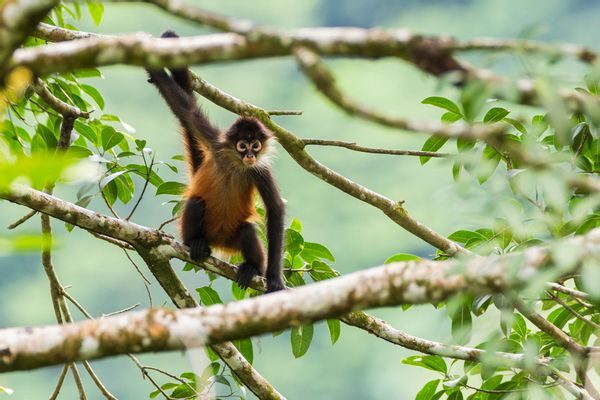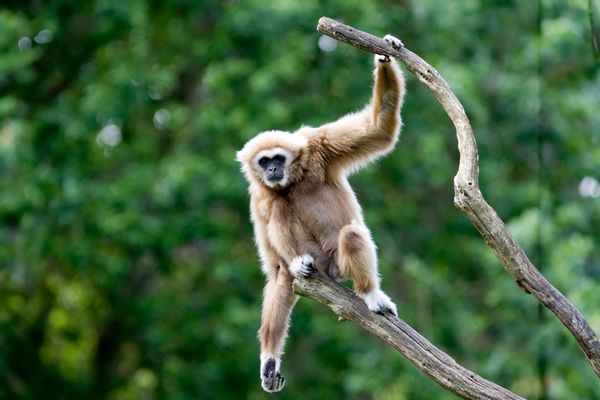
Step into the lush landscapes of tropical rainforests or the wide-open spaces of savannas, and you might witness a captivating show unfolding high in the treetops – the world of monkeys. These clever creatures, distant relatives to humans, bring joy and wonder to the wild. Monkeys have a lot to teach us, from their stunning diversity, unique traits, the threats they faces and the important work being done to keep them safe.
Monkeys form a diverse and sizable mammal category, encompassing the majority of primates. While humans, chimpanzees and other apes share a common ancestor with monkeys, they belong to a distinct primate group that diverged from monkeys millions of years ago. Monkeys generally are smaller than apes and typically possess tails, a feature absent in apes. It's important to note that lemurs, another branch of the primate family tree, reside in Madagascar and are not part of the monkey group.
The world is home to many monkeys, each exhibiting distinct lifestyles. These creatures vary significantly in size, shape, and color, yet they share common traits of intelligence and sociability. Some, like the spider monkey, effortlessly swing through branches, while others, like the capuchin, display remarkable problem-solving abilities. Their expressive faces and lively behaviors make them both fascinating and endearing.
Monkeys inhabit all continents except Australia and Antarctica, with a penchant for making their homes in trees within warm and humid tropical rainforests. Notable locations include the Amazon rainforest in South America and the Congo Basin in Central Africa. However, certain monkey species have demonstrated remarkable adaptability, thriving in challenging environments such as arid savannas or snow-covered mountains. A prime example is the Japanese macaque, commonly known as the snow monkey, equipped with dense fur that aids their survival in the northern regions of Japan, where snow covers the landscape for a significant portion of the year.

However, a more serious reality lies beneath the surface of this enchanting world. Monkeys are facing numerous threats that put their existence at risk. Habitat loss, illegal wildlife trade and conflicts with humans are challenges they grapple with.
Some species, such as the Javan langur and the Cross River gorilla, are on the verge of disappearing due to the relentless impact of human activities.
The struggle becomes even more evident when we look at endangered species like the Tana River red colobus. These primates, once abundant in their habitats, are now critically endangered, pushed to the brink by deforestation, climate change and poaching. Their plight serves as a stark reminder of the delicate balance of our ecosystems and the urgent need for conservation action.
Adding to these concerns is the involvement of monkeys in scientific experiments, raising ethical debates due to their genetic similarities to humans and worries about their welfare. While monkeys are often utilized in research to enhance our understanding of human physiology and diseases, ethical concerns stem from the treatment of these intelligent and social creatures in laboratory settings. Critics argue that invasive procedures, isolation and potential harm to monkeys prompt ethical questions regarding the pursuit of scientific knowledge.

The ongoing debate emphasizes the need for increased transparency, enhanced welfare standards and the promotion of alternative research methods. This ethical dilemma highlights the importance of striking a careful balance between scientific progress and the compassionate treatment of animals, underscoring the urgency for comprehensive conservation efforts to ensure the well-being and survival of these remarkable creatures.
In the face of these challenges, however, there is hope. Conservation efforts are underway across the globe, led by organizations committed to protecting monkey habitats, combating illegal wildlife trade, and involving local communities in sustainable practices. Initiatives like the Gibbon Conservation Center and the Pan African Sanctuary Alliance exemplifies the dedication to safeguarding these primates and the ecosystems they call home.
The Gibbon Conservation Center, for instance, focuses on the well-being and conservation of gibbons, working to rehabilitate and release them back into the wild. Similarly, the Pan African Sanctuary Alliance collaborates with sanctuaries to rescue and rehabilitate monkeys, providing them a safe haven from the threats they face.
Yet, the road to conservation is not without its challenges. It requires not only the efforts of dedicated organizations but also the collective responsibility of individuals. Supporting eco-friendly practices, raising awareness about the importance of preserving natural habitats, and rejecting products linked to wildlife exploitation are small yet impactful steps everyone can take.
In the tapestry of life, monkeys play a vital role, adding color and vibrancy to the natural world. Their survival is not just their own concern; it is a shared responsibility for all of us. As we learn about the enchanting world of monkeys, we must recognize that their fate is intertwined with ours. The disappearance of these playful guardians would not only diminish the beauty of our planet but also reflect a failure in our role as caretakers of Earth.
By supporting conservation initiatives, we contribute to the protection of not only monkeys but the rich biodiversity that sustains life on our planet. It is a call to action, urging us to appreciate and protect the wonders of the wild, ensuring that future generations can also marvel at the playful antics of these incredible creatures. The fate of monkeys is, in essence, a reflection of our commitment to preserving the delicate balance of nature, and by safeguarding them, we secure a brighter, more harmonious future for all living beings.







